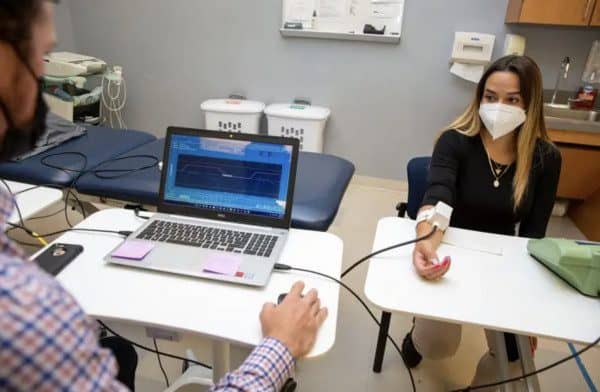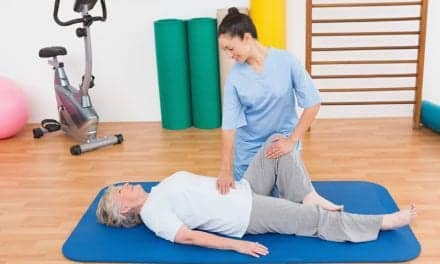PHOTO CAPTION: Ashley Fath, clinical research coordinator for University of Delaware’s Rehabilitation and Neuroplasticity Lab, wears a device that emits heat to induce pain as researchers seek to determine how sensitive someone might be to heat-based pain as part of a larger study on pain and motor learning. Graduate research assistant and doctoral student Patrick Knox (left) is analyzing pain levels on the screen. (Photo credit: University of Delaware/ Ashley Barnas)
Susanne Morton has spent more than two decades studying motor learning. Morton is an associate professor in the Department of Physical Therapy (PT) at the University of Delaware’s College of Health Sciences. She said people with pain are excluded from motor learning studies.
“A lot of people are coming to PT because they have pain, so if I study motor learning but I never look at how pain might be interacting with motor learning, then it’s not helping that many people,” Morton said.
Now, her groundbreaking research, funded through a $2.6 million five-year grant from the U.S. Department of Health and Human Services awarded in March, seeks to determine whether pain hinders motor learning. The findings could impact the future of physical therapy practices, an area in which repetition and practice at home is key to recovery.
“Given that physical rehabilitation is one of the few non-opioid treatment options for pain, and that older adults with pain are markedly more vulnerable to disabilities requiring rehabilitation, it is critical that we gain a fuller understanding of how pain affects motor learning and retention in older adults,” Morton said.
To secure the grant, Morton worked with co-investigator Gregory Hicks, Distinguished Professor of Health Sciences and associate vice president for clinical and translational research, as well as colleagues, Matthew Cohen, associate professor in the Department of Communication Sciences and Disorders, and Ryan Pohlig, director of biostatistics core and assistant professor in the epidemiology program.
Hicks brings expertise in pain and geriatrics to the multidisciplinary project while Cohen brings cognitive assessment skills in the aging population. Pohlig, a biostatistician, will help model the relationships between pain, cognition, aging and motor learning.
The study, which began last spring, delves into pain in young and older healthy adults as well as a group of 75 to 100 people ages 50 and older with chronic lower back pain.
“It’s been noted in literature over the past five years that people with chronic low back pain perform poorly on very specific types of cognitive assessments, specifically tests that look at spatial and verbal working memory,” Morton said. “That very specific aspect of cognition may be important for some types of motor learning.”
Participants in the study will undergo a motor learning assessment and cognitive testing. Then, they’ll be taught an abnormal and asymmetrical walking pattern with an exaggerated limp. Participants will be asked to return to the Rehabilitation and Neuroplasticity Lab the next day to repeat the movement.
“It needs to be novel and something they don’t do in their ordinary, everyday lives,” she said. “We then look at how well the pattern is remembered from the previous day.”
While many clients in PT, regardless of cognitive status, don’t recall new movement strategies, Morton said those who’ve had a stroke or traumatic brain injury have an even more challenging time recalling these skills. Preliminary data from her research shows people that experience pain also substantially forget newly learned movements, hindering a patient’s recovery.
“It doesn’t really matter if they learn and execute a new movement pattern in the clinic but never use it while at work or at home, you have to be able to retain the movement and reproduce it over and over again,” she said.
As part of the study, researchers will induce pain in healthy people in a controlled manner using capsaicin, an active ingredient in pain relief creams that creates a tingling effect.
“It sensitizes the skin to heat, so if you combine capsaicin with a heat pack, then it becomes painful,” she said.
Morton will be testing to determine if pain causes an immediate effect on motor learning.
“When you experience pain, there are a lot of areas in the brain that are affected,” Morton said. “We suspect that the pain is disrupting certain motor learning centers in the brain, leading to a lack of retention of motor skills.”
If her hypothesis is correct and pain hinders motor learning retention skills, Morton’s research could change the way physical therapy is structured in patients with any kind of musculoskeletal pain, post-surgical pain, or pain associated with neurological conditions.
“The use of treatment modalities like heat, massage, or ultrasound are sometimes discouraged in the physical therapy profession because their lasting effects on pain are unclear and because the patient is passive or not performing any activities during that time,” Morton said. “But these approaches could aid in the short-term to alleviate pain so that patients are in less pain during instruction and teaching, making them better equipped to retain new motor skills during physical therapy.”
Physical therapy is often a preferred method of rehabilitation over addictive opioids or surgery, but successful rehabilitation through PT requires repetition both at home and at work.
“For the efficacy of rehab interventions for people with pain, this is a big deal,” Morton said. “My hope is that all physical therapists or rehabilitation clinicians will start to consider how their patients’ pain and their sensitivity to pain is going to impact their capability for learning, and in turn, can modify practices to improve patient outcomes.”
[Source(s): University of Delaware, Newswise]





